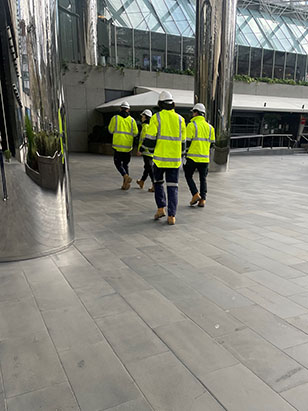Contractor Management Procedure
- Example and Overview
Online Induction >> Contractor Management System
Published 13/09/2025
 Contractor management procedures help clients select and manage contractors to avoid health hazards. The contractor management procedure aims to reduce the financial risks that might occur while executing the contract. A contractor management procedure safeguards the organization from mismanagement of finance and avoids risks. Well, what is a contractor management procedure?
Contractor management procedures help clients select and manage contractors to avoid health hazards. The contractor management procedure aims to reduce the financial risks that might occur while executing the contract. A contractor management procedure safeguards the organization from mismanagement of finance and avoids risks. Well, what is a contractor management procedure?
It is a process that involves a pre-work assessment of the contractor's OHS management and approval of the contractor to undertake the work and ensure the scope of the work is defined within the health and financial risks.
The procedure also ensures that the contractor undertaking the work on behalf of the client is aligned with organizing the client's OSH policy. The contractor management procedure must have a purpose and scope.
The purpose is to guide contractors to meet the health and safety requirements of the client while the scope defines the stakeholders to be involved in the contract.
This forms part of your overall contractor management system and also involves a contractor induction, subcontractor management, contractor prequalification and permit to work management.
Steps for contractor management procedure
When it comes to implementing a contractor management procedure, there are several key steps that should be followed to ensure efficiency and compliance. It's essential to establish clear guidelines and protocols for engaging with contractors, including vetting processes and safety requirements. Communication is crucial throughout the entire process, from initial engagement to project completion. This involves regular updates, documentation of agreements, and ensuring that all parties involved are aware of their responsibilities. Finally, ongoing evaluation and review of the contractor management procedure is necessary to identify any areas for improvement or potential risk factors.Managing contractor relationships effectively requires a comprehensive approach that prioritizes transparency and accountability. Developing a detailed contractor management procedure is paramount in order to maintain consistency and mitigate potential risks. Establishing clear lines of communication and setting expectations from the outset is crucial for successful collaboration with contractors. Additionally, regularly assessing the performance of contractors based on predetermined key performance indicators (KPIs) can provide valuable insights into their contributions and identify opportunities for improvement.
In today's dynamic business environment, implementing an effective contractor management procedure is essential to ensure seamless operations and regulatory compliance. A holistic approach involves defining clear objectives for engaging with contractors while adhering to relevant legal requirements. Fostering open communication channels between all stakeholders facilitates smooth collaboration throughout the project lifecycle. Continual monitoring and assessment of the contractor management procedure enable organizations to adapt to changing circumstances and optimize resource utilization effectively.
Every contractor management procedure has four leading players; managers, responsible officers, employees and contractors. The responsibilities of the key players define steps in the procedure.
Step 1:
The client's responsibility officer tasked with organizing the contractor's work fills in the contractor definition and risk classification form before the contract is awarded. The responsibility officer goes through the scope of work to evaluate the proposed work, the type of contract, estimated budget, potential hazards, and duration. All potential risks are classified according to a scale of low, medium, and high risks.
Step 2:
The classified potential risks are evaluated, and prospective contractors are requested to submit risk assessments. The client informs the prospective contractor of the OSH requirements for low, medium, or high-risk ratings.
The prospective contractor and employees are trained on handle these low risks when they occur. In this step, the contractor must report near misses, incidents, and hazards to the manager. When the contractor completes the work, the client's manager fills in the Post Contract Evaluation.
Step 3:
The manager keeps all records. Reports and documentation generated by the contractor and the client are gathered and put into the record. The reports generated by the contractor are used to evaluate whether or not the contractor is adequate for future work.
Importance of contractor management procedure
- Manage contractor safety and compliance documentation
Collect, review, verify important safety and compliance documentation such as method statements, JSA's, insurances, evidence of training, evidence of safety systems in place, evidence of procedures and policies plus any other materials you require as part of a contractor working on site
- Save the client finance
Risks are directly proportional to capital. When risks are controlled, the client saves finances that could be allocated for hospital bills and compensates injured employees. The contractor management procedure ensures that the contractor adheres to the health and safety protocols set by the client. The client also escapes financial penalties from the government when a contractor management procedure is utilized.
- Future reference tool
The documentation and reports generated by the contractor and client help the latter assess previous contractors' suitability. The contractor management procedure equips the client and contractor with the knowledge and power to negotiate contracts in the future.
- Help the client establish the relationship between the government and the company.
The government enforces policies that must be adhered to by all companies. When the company operates smoothly, it means the relationship is good.
- Help streamline contracts
Contractor management procedures help streamline obligations, saving the client and the contractor time. The client saves effort in vetting the best contractor. It takes the limited client time to maneuver through the existing contracts and create new ones.
- Help in risk management
Contractor management procedures help in risk identification and management. The client is positioned to classify risks that can heavily impact the contract, and their impact cannot stop the project from proceeding.
Technology has simplified everything, including the management of risks. Contractors face these risks while executing tasks, and it's more important to care for the health and lives of people. A contractor management procedure helps streamline site processes to lower the risks. It's upon every organization that outsources activities to other companies to ensure all safety policies are in place. The benefits of having both parties realize one.

Want to try creating your contractor management procedure or use one of our templates?
Building an Effective Contractor Management Plan
A key aspect of building an effective Contractor Management Plan is establishing clear guidelines and expectations for contractors. This includes outlining specific safety protocols, project requirements, and performance standards. Additionally, the plan should address how contractors will be monitored and evaluated throughout the duration of their engagement. By setting clear expectations from the outset, businesses can minimize misunderstandings and potential conflicts while promoting a productive working relationship with their contractors.In addition to establishing guidelines and expectations, an effective Contractor Management Plan should also include strategies for ongoing communication and collaboration with contractors. This may involve regular check-ins, progress updates, and feedback sessions to ensure that projects are on track and any issues are promptly addressed. Open lines of communication can help foster a strong partnership between businesses and their contractors while maintaining transparency and accountability throughout the duration of the engagement.
Other areas might include:
- Permit to Work Procedure
- Contractor Management Process
- Contractor Handbook
What makes an effective contractor management procedure?
Contractors are an important part of the business landscape. As a company, you want to make sure that your contractor management procedure is effective and efficient in order to get the most value for your money. But what makes an effective contractor management procedure? Here we will explore some tips and strategies for creating a successful process as part of your contractor management system.Having clear lines of communication between everyone involved is key in any successful contractor management program. This means having open conversations with contractors about what their goals and expectations are as well as ensuring they know exactly who needs to be informed about progress and changes throughout the project's lifespan. Additionally, having regularly scheduled meetings with contractors can help ensure everyone remains on track while also setting specific deadlines which helps maintain timelines better overall.
Tracking progress through performance metrics can help give insight into how things are progressing from within the company's own system instead of relying solely on anecdotal feedback from contractors - giving real-time updates that demonstrate successes or difficulties encountered along the way so corrective action can be taken if necessary. These three aspects alone create an atmosphere where contract work flows more smoothly making sure both parties have mutually beneficial experiences every step of the way.









